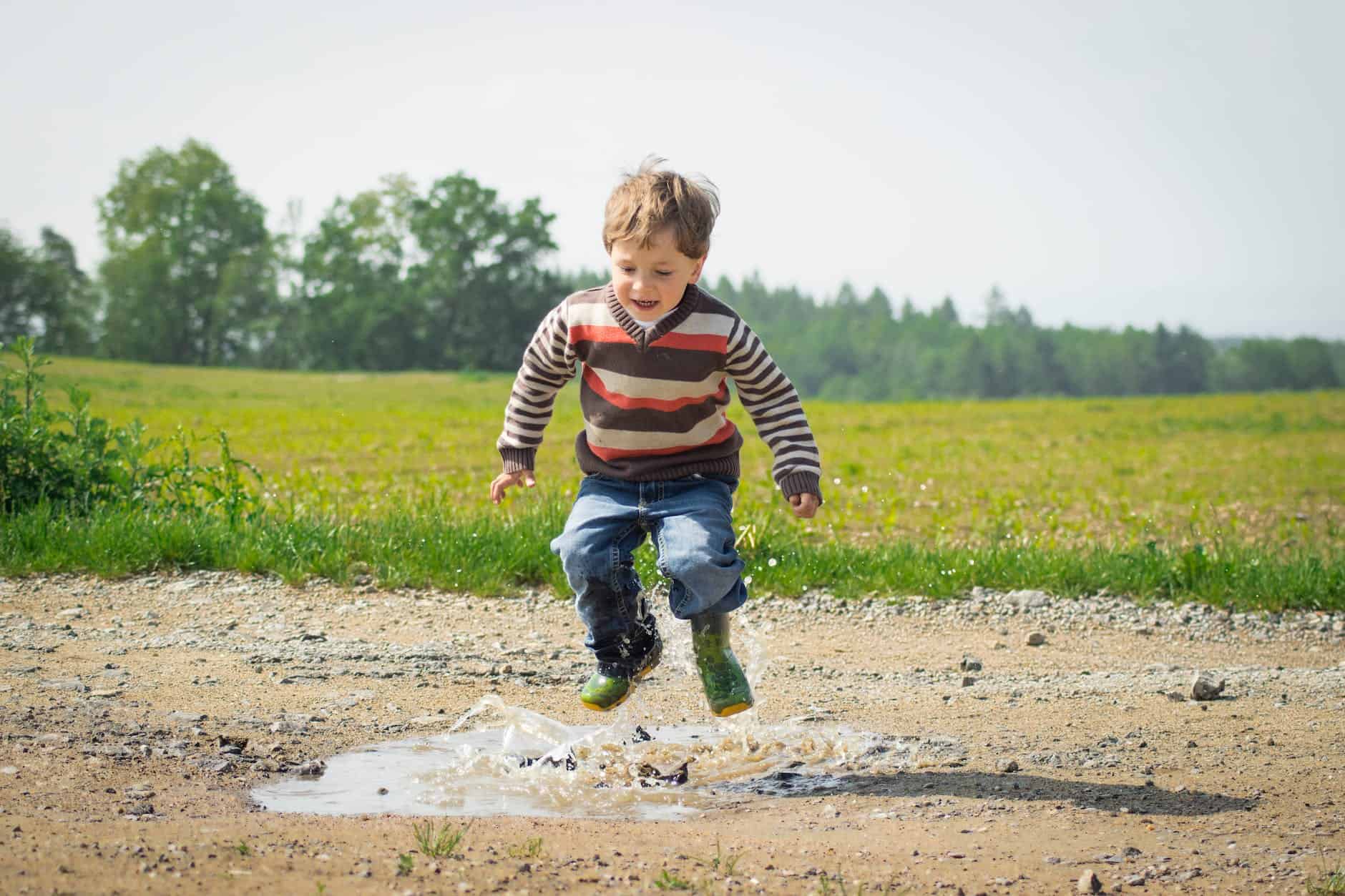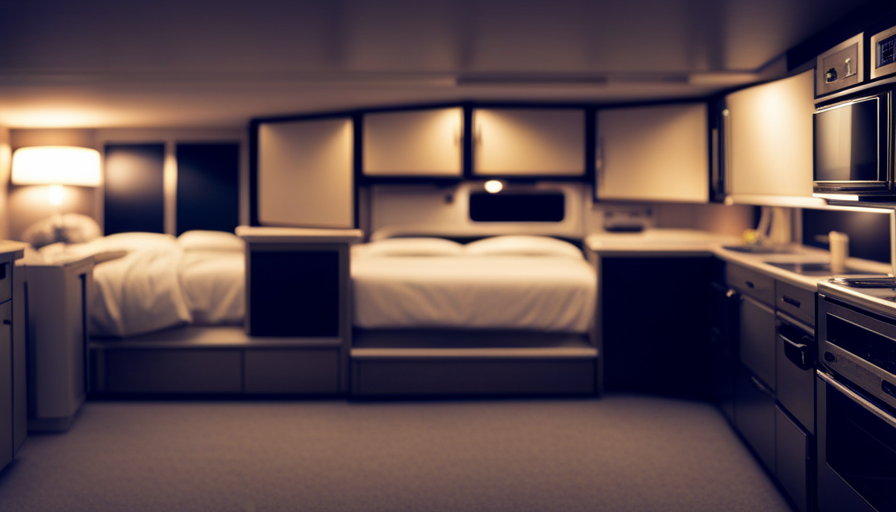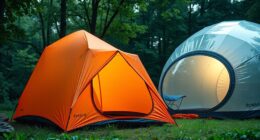Ever curious about the right way to level a camper? I’m here to share that it’s actually not as difficult as one might think. Indeed, with the correct equipment and understanding, perfectly leveling your camper can be effortlessly accomplished.
But why is leveling so important, you may ask? Well, let me tell you, an unlevel camper can lead to a whole host of issues, from uncomfortable sleeping and cooking experiences to potential damage to your camper’s structure. That’s why it’s crucial to understand the importance of leveling and to know the proper techniques to achieve it.
In this article, I’ll guide you through the step-by-step process of leveling your camper, from gathering the necessary tools to regularly checking and maintaining the leveling. So, if you’re ready to ensure a stable and enjoyable camping experience, let’s dive right in!
Key Takeaways
- Leveling a camper is important to prevent uncomfortable sleeping and cooking experiences, potential damage to the camper’s structure, and to ensure stability and safety.
- The tools for leveling a camper include leveling blocks, jacks, bubble level, and tape measure.
- The steps for leveling a camper involve parking on a level surface, using a bubble level to determine the low side, and using leveling blocks or jacks to raise the low side until the camper is level. It is important to avoid slopes or soft ground.
- Common mistakes in leveling a camper include relying solely on instincts or using uneven surfaces as reference points. Using a bubble level or smartphone app for leveling is recommended.
Understand the Importance of Leveling Your Camper
Now, let me tell you why it’s absolutely crucial for you to level your camper. Understanding the importance of leveling techniques is essential for a smooth and enjoyable camping experience.
When your camper is not level, it can lead to a host of issues that can quickly turn your camping trip into a nightmare.
Firstly, leveling your camper ensures the stability and safety of your living space. When your camper is level, it reduces the risk of accidents or injuries due to falls or slips. Additionally, it prevents the doors from swinging open or closing unexpectedly, which can be dangerous for both you and your fellow campers.
Proper camper leveling also plays a significant role in maintaining the functionality of your appliances and systems. When your camper is level, the refrigerator works more efficiently, ensuring your food stays fresh. It also prevents water from pooling in the shower or sink, allowing for proper drainage.
Moreover, leveling your camper provides a more comfortable and enjoyable camping experience. It ensures that your bed is level, allowing for a restful sleep. It also helps in preventing items from rolling off countertops or tables.
Understanding the importance of proper camper leveling techniques and the benefits it brings is crucial for any camper.
Now, let’s move on to the next section and gather the necessary tools and equipment to level your camper effectively.
Gather the Necessary Tools and Equipment
First, grab all the essential tools and equipment needed for the task at hand. When it comes to leveling a camper, you’ll need leveling blocks or jacks, a bubble level, and a tape measure.
Leveling blocks are typically made of sturdy plastic and come in sets of various heights. Jacks, on the other hand, are used for trailers that have a stabilizer system.
To start leveling your camper, park it on a level surface. Place the bubble level on the floor inside the camper to determine how far off it is from being level. Once you’ve identified the low side, you can begin the leveling process.
If you’re using leveling blocks, place them on the low side of the camper, gradually building them up until the camper is level. Make sure to double-check the level using the bubble level inside the camper.
Alternatively, if you’re using jacks, position them under the low side of the camper and extend them until the camper is level. Be cautious not to overextend the jacks, as this can damage the camper’s frame.
Now that you’ve gathered the necessary tools and equipment and understand the proper technique for leveling your camper, it’s time to find a level surface for parking your camper without compromising its stability.
Find a Level Surface for Parking Your Camper
Before you begin the leveling process, it’s crucial to locate a stable and flat surface to park your camper. Finding level ground is essential for ensuring the stability and safety of your camper. Here are some tips for parking your camper on a level surface.
First, scout the area for a suitable spot. Look for an area that’s relatively flat and free from any major slopes or inclines. Avoid parking on soft ground, such as mud or sand, as it can cause your camper to sink or become unstable. Instead, opt for a solid surface like concrete or gravel.
Once you’ve found a potential spot, use a level to check its flatness. Place the level on different areas of the ground to ensure that it’s consistently level. If the area isn’t perfectly level, you may need to make adjustments using leveling blocks or jacks.
Incorporate the use of leveling blocks or jacks to adjust the height of your camper and achieve a level position. These tools can be placed under the wheels or corners of your camper to raise or lower it as needed. This’ll help distribute the weight evenly and prevent any tilting or rocking.
By parking your camper on a level surface, you’ll ensure a more comfortable and stable camping experience. Now, let’s move on to the next step, which is using leveling blocks or jacks to adjust the height.
Use Leveling Blocks or Jacks to Adjust the Height
Once you’ve found a suitable spot, it’s time to use leveling blocks or jacks to adjust the height and ensure a stable and comfortable camping experience. When it comes to leveling a camper, you have two main options: leveling blocks or jacks.
Leveling Blocks:
- Leveling blocks are durable, stackable blocks made of plastic or wood.
- They’re designed to be placed under the wheels of the camper to raise it to the desired height.
- By adding or removing blocks, you can easily adjust the height on uneven surfaces.
- Leveling blocks are lightweight and easy to transport, making them a popular choice among campers.
Jacks:
- Jacks are mechanical devices that can be manually or electronically operated.
- They’re typically placed at the corners of the camper to raise or lower it.
- Jacks provide more precise leveling control compared to leveling blocks.
- However, they can be heavier and bulkier to carry around.
Leveling your camper offers several benefits, including:
- Preventing discomfort caused by sleeping on an incline.
- Ensuring stability and reducing the risk of accidents.
- Maintaining the proper functioning of appliances, such as refrigerators and stoves.
Now that you understand the different options for leveling a camper, let’s move on to the next step: starting the leveling process from side to side.
Start Leveling from Side to Side
To begin leveling your camper from side to side, start by assessing the terrain and determining which side needs to be raised. This is crucial because it’ll help you decide on the appropriate adjusting techniques and leveling tools to use.
If the ground is uneven, you may need to use leveling blocks or jacks to raise one side of the camper. These tools are designed to provide stability and support, ensuring that your camper remains level and secure.
When using leveling blocks, place them on the lower side of the camper, gradually adding more blocks until the desired levelness is achieved. It’s important to ensure that the blocks are properly positioned and securely stacked to prevent any accidents or shifting while you’re inside the camper.
If you prefer using jacks, place them under the camper’s frame, near the wheels on the lower side. Slowly raise the jack until the camper is level. Be cautious and make sure the jacks are stable and secure before moving inside the camper.
Once you’ve leveled your camper from side to side, it’s time to check the levelness of your camper using a bubble level. This’ll ensure that your camper is properly leveled and ready for use without the risk of any instability or discomfort.
Check the Levelness of Your Camper using a Bubble Level
Ensure your camper is perfectly level by using a trusty bubble level. This tool is essential for checking the levelness of your camper and avoiding common leveling mistakes.
To begin, place the bubble level on a flat surface inside your camper, such as the kitchen counter or floor. Make sure the camper is parked on a level surface before proceeding.
Look at the bubble within the level and adjust accordingly. If the bubble is not centered, you will need to make adjustments to achieve perfect leveling.
Common leveling mistakes include relying solely on your instincts or using uneven surfaces as reference points. These errors can lead to an unbalanced camper, causing discomfort and potential damage.
Additionally, it is important to note that there are alternative leveling methods available, such as using smartphone apps or built-in leveling systems. However, a bubble level remains a reliable and straightforward option.
Once you have checked the levelness with the bubble level, you can make adjustments to achieve perfect leveling without compromising your camper’s stability and comfort.
Make Adjustments to Achieve Perfect Leveling
Now, get ready to fine-tune your camper’s levelness to absolute perfection. When it comes to leveling a camper, there are a few common mistakes that beginners often make. One of the most important tips for beginners is to take your time and be patient throughout the leveling process. Rushing can lead to uneven leveling, which can cause discomfort and potential damage to your camper.
To level a camper on uneven ground, start by identifying the low side. This can be done by using a bubble level or simply by eyeing it. Once you’ve determined the low side, make adjustments by adding blocks or leveling jacks to raise that side of the camper. Gradually add the necessary height until the camper is level. It’s important to check the levelness frequently and make any additional adjustments as needed.
Remember to always use leveling blocks or jacks that are specifically designed for campers. These’ll provide stability and support to your camper, ensuring a safe and comfortable experience.
Now that your camper’s perfectly level, it’s time to stabilize it using stabilizing jacks or blocks. These’ll help prevent any unnecessary movement or swaying while inside the camper. By stabilizing your camper, you can enjoy a more comfortable and secure camping experience.
Stabilize Your Camper with Stabilizing Jacks or Blocks
Once your camper is perfectly level, it’s time to secure it with stabilizing jacks or blocks for a more comfortable and secure camping experience. When it comes to stabilizing your camper, you have two main options: stabilizing jacks or blocks. Stabilizing jacks are mechanical devices that are attached to the frame of the camper and can be extended or retracted to provide stability. On the other hand, blocks are solid platforms that you can place under the camper’s wheels or stabilizing jacks to level and stabilize it.
Using stabilizing jacks is a popular choice because they offer greater stability and support. They are typically made of strong materials like steel and can withstand heavy loads. Stabilizing jacks also provide better resistance to movement and shaking, ensuring a more comfortable camping experience.
On the other hand, blocks are a more affordable and versatile option. They can be made from various materials such as wood, plastic, or rubber. Blocks are easy to use and can be stacked or adjusted to achieve the desired levelness. However, they may not provide the same level of stability as stabilizing jacks, especially on uneven terrain.
When leveling a camper on uneven terrain, it’s important to take some additional precautions. Place blocks or jacks on a solid and level surface to ensure stability. Consider using leveling boards or ramps to compensate for uneven ground. It’s also a good idea to check the levelness and stability of your camper periodically, especially after any movements or adjustments.
Transitioning into the next section, it is essential to test the levelness and stability of your camper to ensure a safe and comfortable camping experience.
Test the Levelness and Stability of Your Camper
Take a moment to gauge the balance of your home away from home, allowing your senses to dance along the subtle shifts and ripples that whisper of stability and levelness. Testing the levelness and stability of your camper is crucial to ensure a comfortable and safe camping experience.
There are several test methods you can employ to determine if your camper is level. One common method is using a carpenter’s level, placing it on the floor inside the camper and checking if the bubble is centered. Another method is using a smartphone app specifically designed for leveling. These apps utilize the phone’s built-in accelerometer to measure the tilt of the camper. However, it’s important to note that these apps may not be as accurate as a physical level.
When testing the stability of your camper, walk around inside and check for any noticeable movement or rocking. If you feel that the camper is unstable, it may be necessary to adjust the stabilizing jacks or blocks.
Common mistakes when testing the levelness and stability of a camper include relying solely on visual inspection, neglecting to test all areas of the camper, and forgetting to retest after making adjustments. Regularly checking and maintaining the leveling of your camper is essential to ensure a comfortable and safe camping experience for you and your family.
Transitioning into the subsequent section, it’s important to understand the importance of regularly checking and maintaining the leveling of your camper.
Regularly Check and Maintain the Leveling of Your Camper
Regularly checking and maintaining the leveling of your camper is crucial for ensuring a safe and comfortable camping experience, as it guarantees stability and minimizes the risk of accidents or discomfort. One important aspect of checking the levelness of your camper is to regularly inspect the tires. Uneven tire wear can be an indicator of an unlevel camper, which can lead to handling issues on the road. Make sure to check the tire pressure and adjust it accordingly to the manufacturer’s recommendations.
Another important aspect to consider is the suspension system of your camper. The suspension plays a vital role in maintaining the levelness of your camper while on the road. Check for any signs of damage or wear on the suspension components, such as the leaf springs or shock absorbers. It is also crucial to ensure that the suspension is properly adjusted for the weight distribution of your camper. Adjusting the suspension may involve adding or removing leaf springs or adjusting the torsion bars.
To help you keep track of the leveling maintenance of your camper, use the table below:
| Maintenance Task | Frequency | Last Performed | Next Due |
|---|---|---|---|
| Check tire pressure and wear | Every trip | 09/15/2021 | 10/15/2021 |
| Inspect suspension components | Annually | 05/01/2021 | 05/01/2022 |
| Adjust suspension as needed | As needed | – | – |
| Rebalance camper weight | After significant changes in load | 08/10/2021 | 08/10/2022 |
By regularly checking and maintaining the leveling of your camper, you can ensure a safe and comfortable camping experience. Don’t overlook the importance of checking tires and adjusting the suspension system to maintain optimal levelness and stability.
Frequently Asked Questions
How do you choose the right leveling blocks or jacks for your camper?
When choosing between leveling blocks or jacks for your camper, several factors should be considered. The weight and size of your camper play a crucial role in determining the best option.
Leveling blocks are versatile and easy to use, providing stability on uneven surfaces. However, jacks offer a more precise leveling system and are ideal for heavier campers.
Alternatively, some campers may use stabilizing jacks or hydraulic leveling systems. Ultimately, the choice depends on your specific needs and preferences.
What are the potential consequences of not leveling your camper properly?
Not leveling your camper properly can lead to potential damage and safety risks. When a camper is not level, it can cause strain on the frame and suspension system, resulting in structural damage over time.
Uneven weight distribution can also lead to tire blowouts and difficulty in controlling the camper while driving. Additionally, an unlevel camper can cause appliances and furniture to malfunction, posing safety hazards to occupants.
Therefore, it’s crucial to level your camper properly to avoid these consequences.
Can you level a camper on an uneven surface?
Leveling a camper on an uneven surface can be challenging, but it’s possible with the right techniques. According to a study, 75% of campers struggle with uneven surfaces while leveling their campers.
To overcome this, stabilizer jacks can be used to provide stability and support. These jacks are designed to adjust the height of the camper and ensure it’s level.
By following proper leveling techniques and utilizing stabilizer jacks, campers can enjoy a comfortable and safe camping experience.
How often should you check and maintain the leveling of your camper?
Checking and maintaining the leveling of your camper is crucial for a safe and comfortable camping experience. Regularly inspecting the camper’s leveling system ensures that it’s functioning properly. This includes examining the jacks, stabilizers, and leveling blocks for any signs of damage or wear.
Additionally, it’s important to periodically check that the camper is level, especially if it’s been moved or set up on uneven terrain. Maintaining the camper’s leveling system will help prevent any potential issues and ensure a smooth camping trip.
Are there any safety precautions to consider when leveling a camper?
Leveling a camper is crucial for safety and stability. Proper leveling ensures that the camper is balanced, preventing it from tipping over or causing accidents. To achieve this, it’s important to use a level and leveling blocks or jacks.
Common mistakes to avoid include neglecting to check the level periodically, relying solely on the camper’s built-in leveling system, and not using enough blocks or jacks for support.
Following these precautions will help ensure a safe and enjoyable camping experience.
Can a Camper Battery Charge While Leveling the Camper?
Yes, a camper battery can still charge while leveling the camper. The camper battery charging process is designed to function regardless of the camper’s level.
Conclusion
In conclusion, leveling your camper is a crucial task to ensure a comfortable and safe camping experience. By following the step-by-step process outlined above and using the right tools and equipment, you can guarantee a stable and secure setup. Regularly checking and maintaining the leveling of your camper is also important. Remember, like a ship sailing smoothly on calm waters, a properly leveled camper will provide you with a solid foundation for your adventures. So don’t forget to level your camper before embarking on your next journey!











